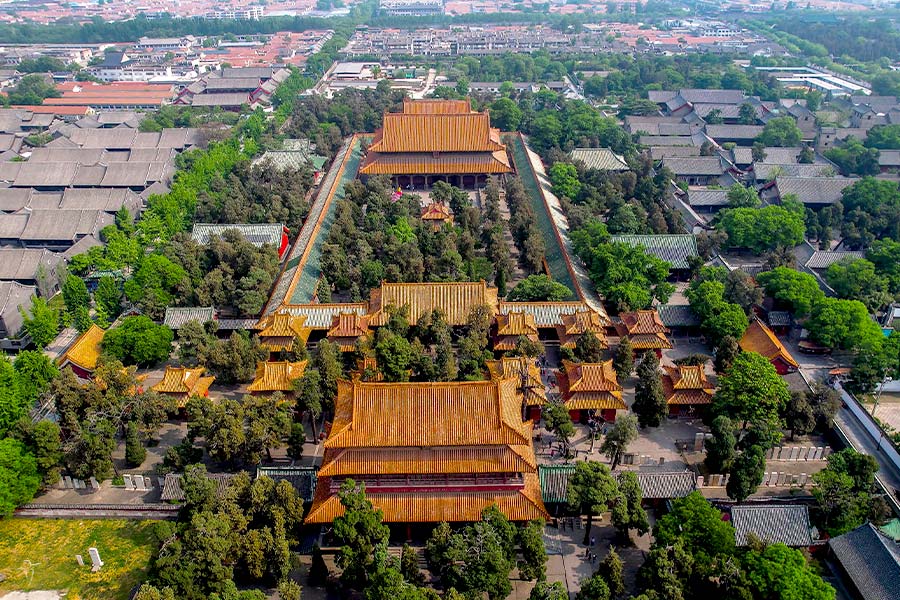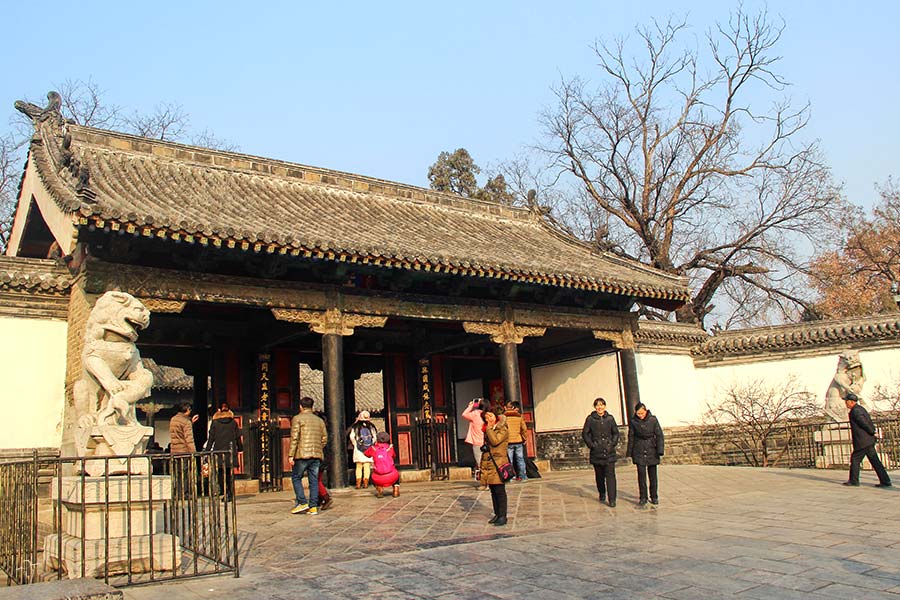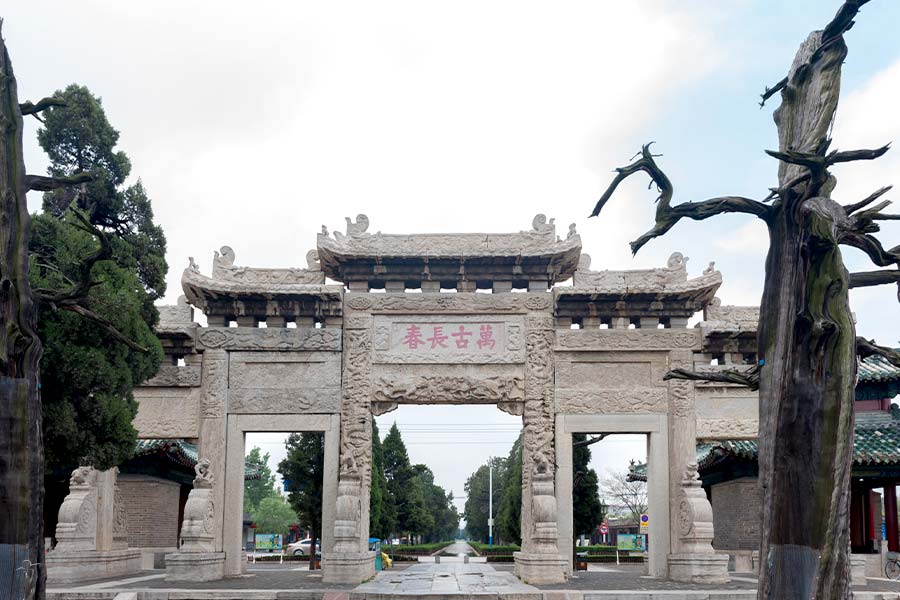Temple, Mansion and Cemetery of Confucius / San Kong

Chinese name: 孔庙孔府孔林/三孔 (Kongmiao, Kongfu, Konglin/ San Kong)
Location: Temple of Confucius is located on Shendao Road; Mansion of Confucius is on the east side of Temple of Confucius; Cemetery of Confucius is on Lindao Road, Qufu city, Shandong province.
Admission fee: 150yuan for San Kong.
Opening time: Temple of Confucius opens from 08:00-17:30; Mansion of Confucius opens from 08:00-17:30; Cemetery of Confucius opens from 08:00-18:00.
How to get there:
- By bus No. 1 and get off at the stop of Guloumen (鼓楼门, Drum-tower Gate);
- By bus No.2, 3, 5, 6 and get off at the stop of Nanmen (南门, South Gate).
Best time to visit: All year round, but habitually people prefer to visit San Kong from March to November, commonly known as the peak season of Qufu.
Introduction to San Kong
San Kong in Qufu refers to Temple of Confucius, Mansion of Confucius, and Cemetery of Confucius. They are symbolic of Chinese people holding Confucianism in esteem and commemorating Confucius, renowned for rich culture, long history, magnificent scale, prodigious relics and scientific and artistic value. Thanks to its phenomenal role in Chinese history and oriental culture, San Kong was designated as World Cultural Heritage Site by UNESCO in December, 1994. Moreover, this one of the three Holy City around the world was listed as China’s first class 5A scenic spots in the year of 2007.
Mansion of Confucius (孔府)

Located in the east side of Temple of Confucius, Mansion of Confucius was originally known as mansion of Yanshenggong. It used to be the house of the descents of Confucius for a long time. When Confucius passed away, his posterity settled down near the temple to attend to the remains of Confucius. By the end of North Song dynasty (960-1127), the mansions soared to more than ten, covering an area of 7.4 hectares. Now there are more than 480 rooms, buildings and halls. The former part is government office and the latter part is the residence.
Entrance (大门)
At the entrance of the mansion guard two stone lions on both sides. Looking up, you will catch a sight of a vertical board inscribed with "圣府", while on the pillars hang a couple said to be written by Ji Yun, a brilliant scholar in Qing Dynasty, from which visitors can learn the dominance of Mansion of Confucius in feudal society.
Second Entrance (二门)
Walking through a narrow but long courtyard leads to the second entrance, commonly known as "Er Men". It was built in the Ming Dynasty, with a vertical board inscribed with "圣人之门" by Li Dongyang, a remarkable poet of Ming Dynasty.
Chongguang Gate (重光门)
After stepping the second entrance, you will catch a sight of a small, lovely, and particular screen door built in the Ming Dynasty. This wood gate was named after the horizontal board inscribed with "恩赐重光" distributed by Jiajing Emperor (1507-1567) of Ming Dynasty.
Hall of Mansion of Confucius (孔府大堂)
Passing through Chongguang Gate, you will find the spacious hall behind the stylobate. In the past, it was where Yanshenggong received other officials, tried a case and ceremonies were held. In the midst of the hall exists an armchair, covered with a tiger skin cushion, in front of which is a red-painted desk.
Second Hall (二堂)
Also called back hall, it was where Yanshenggong received highly-ranked officials, or commissioned by the Emperor, examined the students majoring in music. Two boards inscribed "钦承圣绪" and "诗书礼乐" respectively are in sight, too.
Third Hall (三堂)
Behind the second hall there is a courtyard where two towering junipers stand side by side, while six grotesque Chinese Taihu rocks are in six stone carvings pots. The north room of the courtyard is the third hall, in which Yanshenggong received highly-ranked officials, and his domestic affairs were dealt with.
Gate of Inner Chamber (内宅门)
Two sorts of servants were employed so as to keep in touch with the outside world; one was called Chaipan, the other Neichuanshi. Tens of them were on duty by turns and passed on a message from time to time. The west side of the gate is a special trough via which water carried by laborers could flow into the inner chamber from the outside.
Qianshang Hall (前上房)
Qianshang halls refer to seven rooms of the Mansion of Confucius, where the host received his relatives and bosom friends, and weddings and funerals took place. In the courtyard you are greeted by a luxuriant Aquilaria Sinensis. When it comes to the late spring and early summer, the white flowers scents the air. Four stone drums, laying on the large platform in front of the hall, used to be base of a stage on which theatrical troupe performed for the mansion. In the spacious Qianshang hall hangs a horizontal board inscribed with "宏开慈宇", and a Chinese character "寿" (literally meaning longevity) written by Empress Dowager Cixi (1861-1908).
Qiantang Building (前堂楼)
Passing through a small door brings you to the courtyard of Qiantang building. In the yard, you are amazed and delight to see the charming scenery of towering and elegant pine trees, and a school of fish swimming in the pool. Qiantang building is a two-storey building with seven rooms, furniture remaining its original appearance. In the middle is a bronze-made stove. In the east room, phoenix coronet, ginseng, coral, ivory carvings are in sight.
Houtang Building (后堂楼)
It was the residence of Kong Decheng, the 77th generation of Confucius. Here, his wedding supplies, calligraphies, painting and presents from his friends are displayed.
Back Garden (后花园)
Situated in the backyard of the residence, it is also called Tieshan Garden. However, there are no iron mountains but some iron ores resembling hills in the northwestern corner. The iron ores were transferred by Kong Qingrong in the Jiaqing Period (1796-1820) of Qing Dynasty, and from then on he called himself the master of Tieshan garden. The garden was built in the year of 1503 and renovated three times on a large scale.
Temple of Confucius (孔庙)

This temple is for the Confucius, the great thinker, statesman, and educationist of the Spring and Autumn Period (770-476BC). Located in the middle of Qufu city, it is an oriental architectural complex, magnificent and imposing. One year after Confucius passed away, his disciples converted his dwellings into the temple, and later, it was expanded by successive dynasties. Going through no less than hundreds of repair, the temple had achieved the immense scale in the Ming Dynasty and Qing Dynasty. Covering an area of 33 acres, architecture here are arranged symmetrically, five halls, one pavilion, one altar, two rooms at the sides of the principal rooms, two main rooms and seventeen stele pavilions included. Almost all ancient architects commended this temple due to its large scale, imposing appearance, and integrity despite the elapse of time. It is not only the masterpiece of millions of laborers’ blood, toil, tears and sweat, but also the fruit of their wisdom.
Jinsheng Yuzhen Archway (金声玉振坊)
Mencius once highly praised Confucius by these two words "金声" and "玉振" , literally meaning golden sound and jade vibration, a metaphor said of high moral behavior of Confucius. Therefore, people named the stone archway in front of the Temple of Confucius "金声玉振" . Behind it spans a stone arch bridge, behind which is erected a tablet in the east and west respectively. In the feudal society, emperors had to get off the man-drawn carriage when offering sacrifice to Confucius, to say nothing of the common people.
Lingxing Gate (棂星门)
In the ancient times, people had to offer sacrifice to lingxing before others, so naming the gate after lingxing connotes the status of Confucius as the heaven. A board inscribed with "棂星门" written by Emperor Qianlong is in sight. Inside the gate, there are two archways made of white marbles. As a matter of fact, when Chinese touches upon the profound influence on China, they prefer to use the eight Chinese characters, namely, "德侔天地, 道冠古今", referring to his contributions are as large as the universe and his proposals are always the best. Hence, stepping into the temple, you can find a wood memorial archway, inscribed those characters.
Shengshi Gate (圣时门)
Built in the year of 1415, the gate enjoys five arches now with emerald tiles and ruby outer walls. Looking inside from the arch, you cannot help feeling it like an enigma. But after passing through the gate, you will be delighted to see a spacious grass-studded courtyard, cypresses guarding here and there. In addition, an exquisite bridge called Bishui Bridge.
Daohong Gate (弘道门)
Lying in the north of the Bishui Bridge is Hongdao Gate, under which are two tablets, one recording the transition of Qufu city, the other of high calligraphic value.
Dazhong Gate (大中门)
Originally known as Zhonghe Gate, the gate was constructed in the Qing Dynasty. Its spacious courtyard, green and luxuriant trees, and dancing egrets create deep and serene scenery. Beside the gate are two buildings, for the purpose of making it as solemn as the imperial palace.
Kuiwen Pavilion (奎文阁)
The towering pavilion is reputed for its well-stocked books and unique architecture. Built in the year of 1018, it was first named Cangshu Building and was changed into Kuiwen Pavilion in 1191. 23.35 metres tall, 30.1 metres wide, 17.62 metres deep, the pavilion is so impregnable that heavy rain or sever earthquake cannot destroy it. No wonder it is the remarkable wood architecture in China. In front of the pavilion are two pavilions of four imperial tablets of Ming Dynasty. Each tablet is over six metres tall and two metres wide, and most of them express the reverence for Confucius.
Thirteen Stele Pavilions (十三碑亭)
Thirteen stele pavilions are erected in order to preserve the tablets of emperors, with eight in the south and five in the north. There are fifty-five tablets, ranging from the Tang Dynasty (618-907) to the Republic of China (1912-1949). Most of the tablets document the renovation history of the temple, and the reverence for Confucius by the emperor.
Dacheng Gate (大成门)
In the north of the thirteen stele pavilions is Dacheng Gate. With five gates side by side, the temple is divided into three parts, the east one is Chengsheng Gate, having a concentration of ancestors of Confucius; the west one is Qisheng Gate, where Confucius’ parents are enshrined; the middle one is Dacheng Gate; the left one is Jinsheng Gate; the right one is Yuzhen Gate.
Apricot Altar (杏坛)
It is said to be the place where Confucius gave lectures. With carved beams and painted rafters, the altar has an exquisite stone censer in front, a few apricot trees beside. In the spring red flowers flickers in the wind.
Two Rooms at the Side of the Principal Rooms (两庑)
These two rooms, just at the east and west side of Dacheng Hall, are places for the posterity to worship a galaxy of Confucian school, such as Dong Zhongshu, Han Yu, Wang Yangming and the like. Now, stone tablets are displayed in the rooms, which are art treasures of high historic value.
Dacheng Hall (大成殿)
Seen from the north of Apricot Alta, this golden Dacheng hall comes into your eyes. The sapphire vertical board is inscribed with three golden Chinese characters – 大成殿 – by Emperor Yongzheng of the Qing Dynasty. Dacheng hall is the main hall of Temple of Confucius, 24.8 metres tall, 45.78 metres wide, and 24.89 metres deep, and deemed as one of the greatest oriental halls, together with the Imperial Palace, Tiankuang Hall of Dai Temple. In the middle of the hall is enshrined with the figure of Confucius that is 3.35 metres tall and dressed as an emperor. Not only is the statue surrounded by other sacred statues, but also musical instruments and dancing apparel are displayed. Outside the hall hang ten horizontal board and three couplets, all of which are exquisite and elegant. The hall, constructed on two-tier bases, connects a terrace which is two metres tall, 4.5 metres wide, and 35 metres long. When it comes to 28th, September of lunar year, dances are performed here in celebration of the birth of Confucius.
Qin Hall (寝殿)
One of the three greatest architectures is Qin Hall, a special ancestral temple for worshiping the wife of Confucius. The hall is so well decorated that it looks like a palace of the empress.
Shengji Hall (圣迹殿)
Behind the Qing Hall, Shengji Hall was built in the year of 1529, and is famous for the preservation of stone carvings, picture-story books, paintings relevant to Confucius. Many portraits drawn by notable artists like Gu Kaizhi of Jin dynasty (265-240), Wu Daozi of Tang Dynasty (618-907) are also seen in the Shengji Hall. So, all these relics are of great historic and artistic value.
Cemetery of Confucius (孔林)

Located in the north of Qufu city, it is the exclusive Cemetery of Confucius and his families. At the same time, it is the largest clan cemetery of the longest history around the world. The number of trees in the cemetery has reached more than ten thousands since Confucius’s disciple Zigong firstly planted. According to the remarkable scholar Guo Moruo, Cemetery of Confucius is not only a natural museum but also a chronicle of the Kongs. In the beginning, when Confucius passed away, his pupils buried him along the Sishui River of Shandong province, and later, as the status of Confucius was raised, the scale of cemetery was expanded. Now the wall of the cemetery is as long as 7.25 kilometres, 3 meters tall and 5 metres thick, covering an area of 2000 square metres, much bigger than the Qufu city. As the clan cemetery, burial has been uninterrupted during the two thousand years, so it remains a valuable source for the study of funeral custom since the Spring and Autumn period. As yet, there are more than ten thousand trees, some of which are even strange for common people! No wonder it is entitled to the epithet of natural botanical garden. In effect, Cemetery of Confucius deserves the name of tablets forest, in that pyramids of tablets inscribed by celebrities of different generations can be found here and there.
Sprite Way (神道)
Stepping in the north outside the Qufu city will lead you to a cypress-lined path, amid which stands a Wanguchangchun memorial archway. It is supported by six stone pillars, with twelve stone lions couching on both sides. In the east and west side of this elegant and magnificent memorial archway is an emerald-tiled pavilion, in which is erected a stone tablet.
Zhushui Bridge (洙水桥)
Zhushui Bridge spanning Zhushui River has its history of renovation on the tablets in its south and north end. A quadrangle dwelling in the north end of the bridge is called Si Tang, which used to be the locker room for people offering sacrifice to Confucius. On the inner wall are embedded with pyramids of tablets paying tribute to Confucius.
Xiang Hall (享殿)
You are greeted by Dangmu Gate with green tiles before you reach the Xiang Hall. Paved path leading to Xiang Hall has four pairs of stone carvings, each of which is exquisitely made. Now in the hall you can find lines written by Emperor Hongli (1711-1799) of Qing Dynasty.
Tomb of Confucius (孔子墓)
It is the centre of Cemetery of Confucius. The tomb, resembling the horse back, is surrounded by a red wall, and is inscribed with "大成至圣文宣王墓" by Huang Yangzheng in 1443. In front of the tomb lies a stone platform, while in the east of tomb of Confucius is his son’s and in the south is his grandson’s.
Cottages of Zigong (子贡庐墓处)
Zigong, who had kept his teacher Confucius’ tomb for three years together with his classmates, did the guarding alone for another three year. Therefore, people built three cottages in the west in honour of this touching event. Behind the Xiang Hall stands a pavilion, in which a tablet is inscribed with an ancient Pistacia chinensis. It is said that Zigong hastened back upon the death of his teacher’s death and planted this tree next to the tomb, but in the Qing Dynasty was destroyed. So people had the image of the tree carved on the tablet.
Tomb of Kong Shangren (孔尚任墓)
In the northeast of Cemetery of Confucius, you can discover a huge tablet erected along the road, that is the gravestone of Kong Shangren, the playwright of Qing Dynasty and author of The Peach Blossom Fan. Looking westward, you can see tomb collections of Han dynasty and Ming Dynasty.
Memorial Archway of Lady Yu (于氏坊)
It was said since the daughter had a pigmented naevus on her face, which was likely to bring her disaster, she must marry a descendant of the sage, but as intermarry between the Han nationality and the Manchu was forbidden at that epoch, Emperor Qianlong designated Yu Mingzhong as her daughter’s adopted father. In this way could Lady Yu get married to the Kong family. So this memorial archway was set up for the lady.
Quick Questions
Our team is waiting for your questions. Please feel free to ask us any questions you might have about our China package tours, Chinese culture, or the sites available. We will gladly help you with any special needs you might have and all questions, like our trip designing is completely free of charge.




